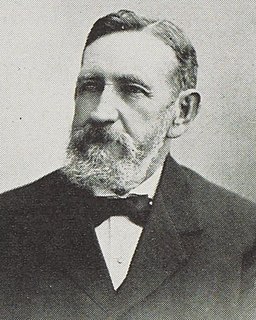Related Research Articles
William Wells was a New Zealand politician.

Richard Harman Jeffares Reeves was a New Zealand politician of the Liberal Party. He was acting Speaker of the Legislative Council in 1905.
Gladstone was a parliamentary electorate in the Canterbury region of New Zealand, from 1866 to 1890.
Wairau was a parliamentary electorate in the Marlborough Region of New Zealand. It was one of the initial 24 New Zealand electorates and existed from 1853 until its abolition in 1938, when it was succeeded by the Marlborough electorate. The electorate had 13 representatives during its existence. The 1861 election in the Wairau electorate was notable in that a later Premier, Frederick Weld, was unexpectedly and narrowly defeated by William Henry Eyes.
Waimea was a parliamentary electorate in the Nelson Province of New Zealand, from 1853 to 1887. Initially represented by two members, it was a single-member electorate from 1861.
James Balfour Wemyss was a 19th-century member of Parliament for Nelson, New Zealand.

John Fedor Augustus Kelling, JP, known as Fedor Kelling, was a 19th-century Member of the New Zealand Parliament, representing Nelson. A leader of a group of immigrants from Germany, he also served as the German consul.

Edward Baigent was a 19th-century Member of Parliament from Nelson, New Zealand. He was one of the most successful saw-millers of the region, and his company existed for well over 100 years.

John Kerr was a 19th-century Member of Parliament from Nelson, New Zealand. As well as Lake Station, Kerr also owned the 70,000 acres (28,000 ha) Tarndale Run and 30,000 acres (12,000 ha) around the Wairau River before entering into a business partnership with Molesworth Station owner Acton Adams. Kerr commissioned cob builder Ned James to build Tarndale homestead in 1874.
Joseph Shephard was a 19th-century Member of Parliament from Nelson, New Zealand.

Arthur Shuckburgh Collins, later spelling his surname Collyns, was a 19th-century Member of Parliament from Nelson, New Zealand.

Martin Lightband was a 19th-century Member of Parliament from Nelson, New Zealand.
William Gibbs was a 19th-century Member of Parliament from the Nelson Region of New Zealand.

Jesse Piper was a Nelson, New Zealand city councillor and mayor.
Henry Redwood was a New Zealand farmer, politician and racehorse breeder.

John Wallis Barnicoat was an English civil engineer and surveyor who emigrated to New Zealand. In his chosen homeland, he became a local politician in Nelson. Towards the end of his life, he was a member of the New Zealand Legislative Council for 19 years.

The Wairau by-election 1872 was a by-election held in the Wairau electorate during the 5th New Zealand Parliament, on 19 February 1872. The by-election was caused by the resignation of incumbent MP William Henry Eyes and was won by Arthur Seymour, who defeated Joseph Ward. Both candidates were prominent Marlborough politicians, and for both of them, this was their first attempt at election to the General Assembly.
The 1861 Suburbs of Nelson by-election was a by-election held on 20 June 1861 in the Suburbs of Nelson electorate during the 3rd New Zealand Parliament.
The 1873 Suburbs of Nelson by-election was a by-election held on 14 May 1873 in the Suburbs of Nelson electorate in Nelson during the 5th New Zealand Parliament.
Ruth Atkinson was a New Zealand activist who was involved in the Temperance movement and women's rights movement. From 1910 until her death was the president of the Women's Christian Temperance Union of New Zealand branch in Nelson. In 1919, she was chosen by the organization to participate in the Inter-Allied Women's Conference, a parallel conference to the 1919 Paris Peace Conference.
References
- Scholefield, Guy (1950) [First ed. published 1913]. New Zealand Parliamentary Record, 1840–1949 (3rd ed.). Wellington: Govt. Printer.
- Wilson, James Oakley (1985) [First ed. published 1913]. New Zealand Parliamentary Record, 1840–1984 (4th ed.). Wellington: V.R. Ward, Govt. Printer. OCLC 154283103.